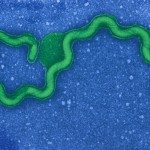Link to Pubmed [PMID] – 32986693
Link to DOI – 10.1371/journal.pntd.0008662
PLoS Negl Trop Dis 2020 09; 14(9): e0008662
Leptospirosis is a widespread zoonosis with global impact, particularly among vulnerable populations in resource-poor settings in tropical countries. Rodents have been considered to be the main reservoir of the disease; however, a wide variety of mammals can act as hosts as well. Here we examine the genetic diversity of Leptospira strains from biological samples of patients and animals in French Polynesia (FP) from 2011 to 2019.From 2011 to 2019, we have collected 444 blood samples from patients diagnosed as having leptospirosis. The limited volume of clinical material and low amount of leptospiral DNA in blood samples led us to develop a nested PCR targeting the secY locus that enabled us to amplify and sequence 244 samples (55%). In addition, 20 Leptospira strains recovered from the blood of patients from 2002 to 2011 were sequenced and fully characterized at the serogroup level and used as reference strains for the association of different phylogenetic branches with respective serogroups. The secY sequences were compared with publicly available sequences from patients and animal reservoirs in FP (n = 79). We identified rats as the main source of infection for L. borgpetersenii serogroup Ballum and L. interrogans serogroup Icterohaemorrhagiae, dogs as the main source of infection for L. interrogans serogroup Australis, and farm pigs as the main source of infection for L. interrogans serogroups Pomona or Canicola. L. interrogans was associated with the most severe infections with 10 and 5 fatal cases due to serogroups Icterohaemorrhagiae and Australis, respectively. Mortality was significantly associated with older age (p-value < 0.001).We described the population dynamics of leptospires circulating among patients in FP, including two patients who were reinfected with unrelated Leptospira genotypes, and clarified the local role of the animal reservoirs in the transmission route of leptospirosis to humans. Routine Leptospira genotyping directly on biological samples should allow the epidemiological follow-up of circulating strains and assess the impact of control interventions on disease transmission.

